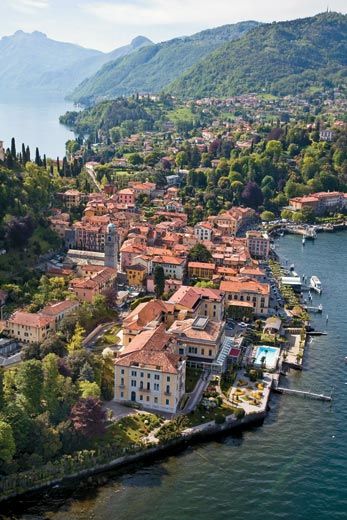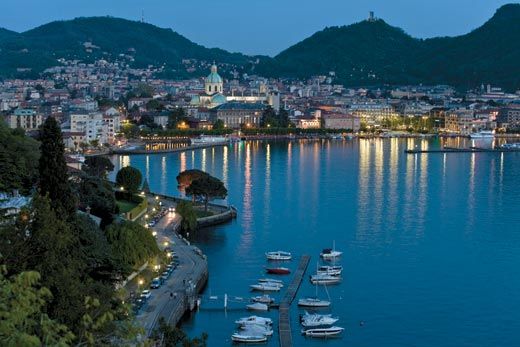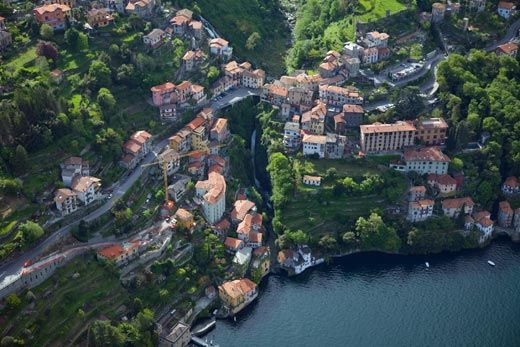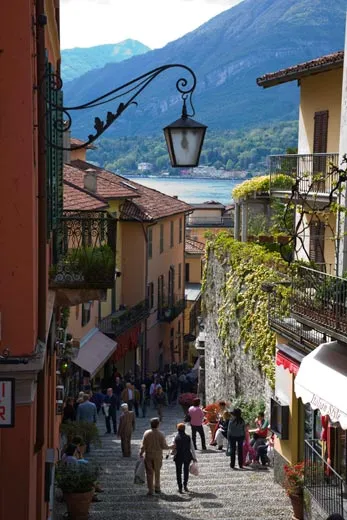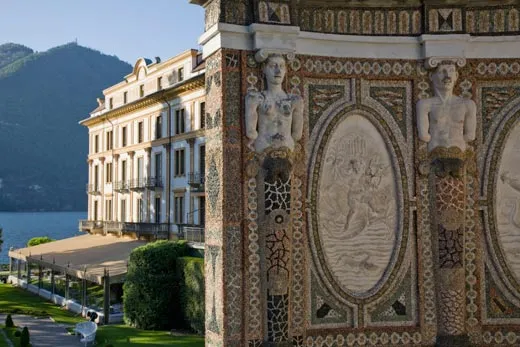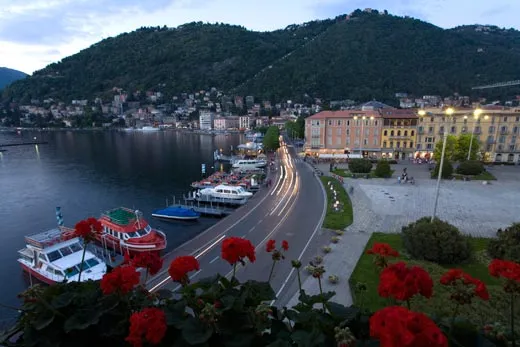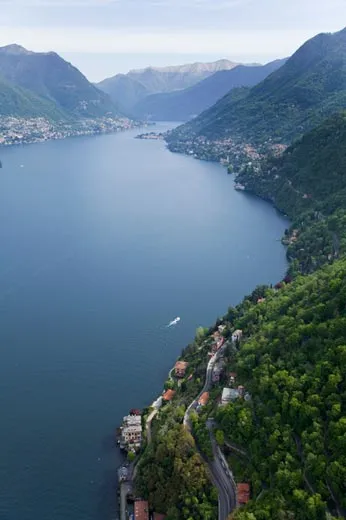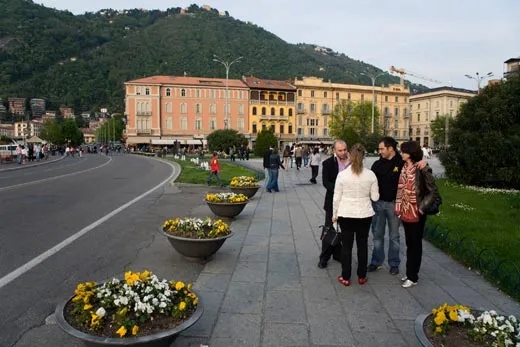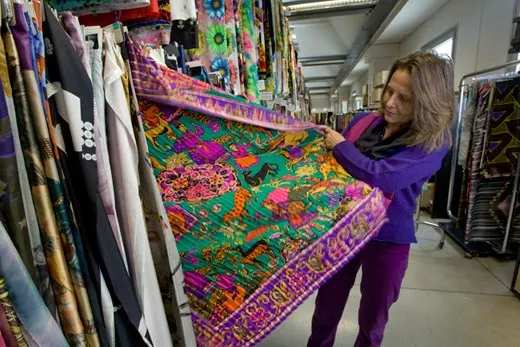Silken Treasure
The Italian city of Como, celebrated for its silk and scenery, has inspired notables from Leonardo da Vinci to Winston Churchill
"The silkworm is a snob," says Moritz Mantero. "He'll eat anything, but he produces silk only if he eats mulberry!" Mantero is the third-generation owner of Mantero Seta SpA, one of the largest silk manufacturers in Como, Italy. Situated three miles from the Swiss border in northern Italy's lake country, Como supplies silken goods to the fashion houses of New York City, Paris and nearby Milan. Although the backbreaking labor of cultivating the voracious and picky silkworms left Italy after World War II—returning to China, whence it had come centuries earlier—the finishing end of silk production stayed here and expanded. Today in Como and its surrounding foothills, there are 800 companies engaged in the silk and textile trade—manufacturing, printing, dyeing, designing, selling. And more than 23,000 Comaschi, as Como residents are called, work in the business. In 2007 they turned out some 4,400 tons of silk fabric. If you own a silk scarf, tie, blouse or dress by any big-name fashion house, from Armani to Zara, chances are the silk came from Como.
The city, which is also the tourist hub of Lake Como, one of Europe's deepest and most picturesque lakes, is to luxury silk what Reims is to Champagne and Modena to fancy sports cars. Since the manufacturing of silk for the mass-market end of the rag trade migrated largely to China in the past two decades, Como has concentrated on the high-end market, which means fast turnaround for two or three collections a year, sometimes even including final delivery directly to the boutiques of a client like Chanel. "That's the total service they expect," says Mantero of such world-famous designers as Versace, Prada and Ralph Lauren. China, he says, is too far away and too slow to meet the fast-changing demands and relatively small orders of luxury fashion houses.
"Service is not just a practical matter, it's a matter of culture," says Guido Tettamanti, secretary of the Italian Silk Association. "The Como suppliers speak the language of the fashion houses. It's not just the client who proposes. Como also proposes."
Como became Italy's silk capital for two reasons, silk makers say. First, there was an ample supply of water from the lake and nearby alpine streams to the north. Second, there was widespread mulberry farming in the Po River Valley just to the south. Mulberry, native to Italy, was often planted as a field and property divider. This made the region a natural for the cultivation of silkworms.
For me, there's a third reason: the town's physical setting—a palm-lined fjord with an improbable Mediterranean climate and snowy ridgelines in the near distance—may be unmatched in the world. Even its man-made attractions, especially the grand 16th- to 19th-century villas that dot its shores, suggest that adding to the sum of beauty on earth is what is supposed to happen here. And it does—in the silk, in the architecture and in the lifestyles. "We call it la cultura del bello," says Tettamanti. "The culture of beauty."
That culture was on full display as I set out to explore the city and its lakefront one sparkling fall day. The water glinted between sharp Swiss peaks on one side and rolling Lombard hills on the other. Ferries and fishermen skittered across the lake's surface like bugs on the hunt. Small seaplanes buzzed in and out of the Aero Club at the water's edge. Stone structures and ocher facades lined the city's streets, which hummed with the energy of Italian life. A market was selling regional sausages, cheeses and olive oil; mimes and accordionists entertained on the Piazza Duomo; and families bought gelati from a kiosk in a lakeside park next to the Volta Temple, a museum-cum-memorial to Alessandro Volta, a local aristocrat and physicist who in 1800 invented the voltaic pile, an early electric battery.
In Como's lively pedestrian zone—within the old walled Roman city founded when Julius Caesar sent 5,000 men to colonize the place 2,000 years ago—young couples with strollers greeted other young parents on the flagstone-paved streets. Exuberant youngsters chased pigeons and darted around on bicycles, while teenage rakes chatted up chic young women in sidewalk cafés.
Reminders of silk were everywhere. Along Via Vittorio Emanuele II, the main shopping street, designer boutiques splashed silken wares in their windows. On the Piazza Cavour, the main square opposite the town's ferry port, a large emporium offered a profusion of silk products. And just outside the city walls, La Tessitura, a store opened by Mantero in a former textile mill, featured a restaurant called the Loom Café.
Both the city and lake of Como have been drawing visitors for centuries. Many who came were wealthy, which is reflected in the exceptional concentration of villas—palaces, really—that line the inverted Y-shaped lake. Arrayed against rising dark hills, the villas look like set pieces for a movie backdrop. (Indeed, many movies—including Casino Royale, Star Wars: Episode II Attack of the Clones and A Month by the Lake—have been filmed here.)
Notables, too, have been coming since Roman times. Both Plinys, Elder and Younger, were born here and Pliny the Younger built two country houses along the lake—one named Tragedy, the other Comedy. Leonardo da Vinci visited and was said to incorporate scenic elements from the area in some of his canvases. In 1568, Cardinal Tolomeo Gallio constructed what is probably the most famous building on the lake, now known as the Villa d'Este. The Renaissance-style palace, originally built right on the water's edge in the town of Cernobbio, was designed by a leading architect of the day. In 1815 the building passed into the hands of German Princess Caroline of Brunswick, the estranged wife of George IV, Prince of Wales. Caroline spent the next five years upgrading the house—adding a library and a theater and expanding the terraced hillside gardens—and putting on gala parties. In 1873 the estate became a hotel, eventually hosting such boldface names as Frank Sinatra and Ava Gardner, the Duke and Duchess of Windsor, Alfred Hitchcock and Mikhail Gorbachev. Today's guests—who pay $1,000 and up per night for accommodations—include movie stars, Russian oil magnates and American business leaders.
In the 19th century, a parade of writers—Stendhal, Wordsworth and Shelley among them—spread the word of Lake Como's charms. "I ask myself, Is this a dream? / Will it vanish into air? / Is there a land of such supreme and perfect beauty anywhere?" Longfellow wrote of the lake. Liszt, Bellini and Verdi composed music on its shores. After World War II, it was a destination of choice for both Winston Churchill, who painted from a villa in the village of Moltrasio, and Konrad Adenauer, the first postwar German chancellor, who summered in Menaggio.
Today a new generation of famous visitors is descending on Lake Como. The best known is the actor George Clooney, who in recent years has purchased two villas in Laglia, a lakeside village six miles north of Como. "People sometimes call us Lake Clooney," says Jean Govoni Salvadore, the longtime public relations director at the Villa d'Este. Others have apparently started calling Laglia, formerly a sleepy stop on the lake's ferry route, "Georgetown." At least that's what I was told by Sergio Tramalloni, a member of Como's very active seaplane club, as he flew me over the lake and pointed out Clooney's property.
Clooney's presence has reportedly attracted a stream of other celebrity visitors and would-be villa owners. Last year, Vanity Fair cited Italian newspaper reports that Tom Cruise, Bill Gates, Richard Branson and recently re-elected Italian Prime Minister Silvio Berlusconi had all either purchased or were shopping for Lake Como villas. The Comaschi watch all this with mixed feelings. They are happy to see fresh money reviving hotels and restoring stately properties. But they also know that gentrification and the influx of celebrities come at the cost of increased traffic and, now, dramatically inflated real estate prices.
While the arrival of Clooney and friends may have captured Como's headlines, silk makers and fashion houses still shape its spirit. Mantero, dapper in a pale-blue spread-collar shirt and handmade silk tie, leads me through the design ateliers and consulting rooms of his company's headquarters—a stately urban villa with dark wainscoting, broad hallways and coffered ceilings. In what looks like a professor's study, four people lean over a stack of large design albums. "That's Ferragamo on one side and our designers on the other," Mantero whispers. "They're planning some new scarves."
We walk across a glassed-in bridge from the villa to the design ateliers, where another team is gathered around a long table. This group is finalizing a design for dress material. In the main atelier—a huge room with light streaming in through high windows—I see a dozen or more designers working with pencil, pen, brush and computers. "All these people are artists," says Mantero. "Everything we do starts by hand. It would be far cheaper to do it all by computer, but that's not what our clients want. They want to know that every design is hand-done."
A woman named Donatella (she shyly declines to give her last name) painstakingly draws tiny butterflies, mosquitoes and whimsical flowers for a blue-and-gray scarf design ordered by Liberty of London. At another table, designer Mauro Landoni scans Donatella's drawings into a computer, creating files that will ultimately produce the porous screens that are used for printing on silk. Each will allow a single color to pass through onto bolts of off-white silk stretched out on printing tables that are nearly the length of a football field. The design of a single scarf may need as many as 30 to 35 screens. Landoni's computer scans will also create stencils for weaving dyed silk yarns into a desired design.
A few days after my tour of Mantero's operations, Donatella Ratti, president of the Ratti Group, the other best-known silk company in the Como area, takes me on a tour of her offices. Situated on a plateau about 12 miles from Como with an unobstructed view of the Lombardy Alps, the headquarters houses administrative, sales and design teams in a single, 50,000-square-foot room. "We put women's scarf designers near the home furnishings people," says Ratti, "so each knows what the other is doing."
Style consultant Fabio Belotti, whose wild white hair makes me think of Albert Einstein, tosses silk swatches and design books around as he explains how he and his staff work with the fashion houses to find a winning look for the next collection. "Today we have to be very fast," he says. "In the United States they all do eight collections a year. We try to find something we love, but sometimes the client wants something else, so we collaborate with them."
Touring Ratti's printing plant, I'm amazed by the complexity of the process: the thousands of dye variations in what is called the "color kitchen," the ceiling-high racks of hundreds of silk screens, the baskets full of hanks of raw silk from China and the creative interchange between the print technicians and the designers. At one long table, a man was doing something I'd never before seen in previous visits to silk country: painting, not just printing, a long bolt of silk. Renato Molteni, who refuses to call himself an artist, was making art. Dipping a spatula—"they want the spatula look," he told me—into his dye buckets, he was creating, over and over again, an array of flowers on a large swath of silk. The diaphanous design—beige on white, with tinges of gray—was for dress material ordered by the Milanese fashion house of Dolce & Gabbana. One can only imagine what those dresses are going to cost. Molteni says simply, "You have to watch out that the flowers don't get too big."
"Creativity and high quality, that's our way to survive," says Ratti. "The Chinese are good at doing big quantities. They are not interested in making luxury. It's difficult, it's hard, it's expensive. They can't understand why we would print only 100 meters of something. But there are new rich people in the world—in China, in India, in Russia. They want luxury. They want real Ferraris, real Rolexes, real Hermès. They want Europe."
Former Time foreign correspondent Peter Ross Range writes about travel and international affairs.
Photographer Scott S. Warren is based in Durango, Colorado.
